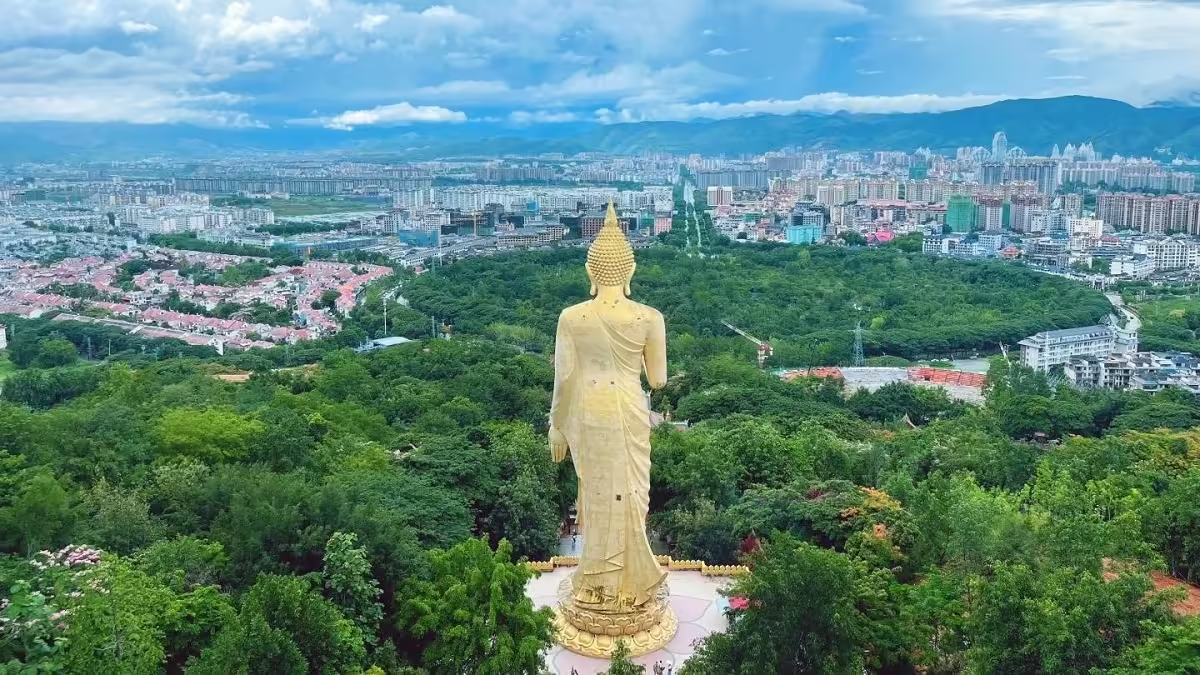Mengle Dafo Temple (Mengle Big Buddha Temple, 勐泐大佛寺) is located in the southern suburbs of Jinghong City, Xishuangbanna Prefecture, on the slopes of Nanyue Mountain. The temple is uniquely built to complement the natural landscape, resembling a seated Buddha from a distance. The entire complex features a predominant yellow color, exuding a golden and majestic appearance, especially shining brightly under the sun.
The area showcases the life of Siddhartha Gautama (Buddha) and the activities of the temple, seamlessly integrating the stunning natural scenery with the architectural design. This reflects the rich history and cultural significance of Theravada Buddhism. Surrounding the temple are breathtaking views, and from the Wanfo Tower, visitors can overlook the entire Jinghong area, surrounded by beautiful tropical landscapes.
The temple has three gates. The central gate, known as the Dharma Gate, features the temple’s name, “Mengle Dafo Temple,” inscribed in both Chinese and Dai scripts. The right gate serves as the entrance, named the Buddha Connection Gate, welcoming sincere worshippers. The left gate is the Exit Gate, designated for those returning after gaining insight. Flanking the temple gates are four fierce Vajra protectors, each brandishing an axe and a staff, guarding the temple.
Upon entering the main gate, visitors are greeted by the Prince Square, where a golden statue of the young Buddha stands, poised on a lotus flower beneath a fountain, with one hand pointing to the sky and the other to the ground, symbolizing his supreme status. The Dai people hold water in high esteem, and dragon motifs are prevalent throughout the temple, particularly along the stairs. At the entrance of the main hall, a protective dragon goddess stands guard.
On either side of the Prince Square are statues representing the twenty-eight generations of Buddhas, serving as a gathering place for followers to listen to teachings and promote Buddhist doctrine. The stone steps are flanked by two enormous seven-headed dragons that decrease in size as they ascend.
The main hall was rebuilt on the site of the original Jingpiao Temple. It serves as the core structure of the temple, where monks gather for daily practices. The hall’s dimensions are based on the significant dates of Siddhartha’s life – 49 meters long, 29 meters wide, and 35 meters high – making it a quintessential example of Buddhist architecture in Xishuangbanna.
Inside the hall, a seated statue of Siddhartha Gautama is enshrined, made entirely of gold with attendants flanking him. The statue’s features and attire prominently reflect Dai ethnic characteristics, appearing lifelike. The hall’s walls and corridors are adorned with exquisite murals depicting the Buddha’s teachings. The temple attracts countless devotees throughout the year, filling the air with sacred chants.
Adjacent to the main hall is the Buddhist Academy of Mengle Dafo Temple. In Xishuangbanna, the Dai people predominantly practice Theravada Buddhism, and boys aged 8 to 10 often enter the temple to live as monks and receive religious education. In addition to studying Buddhist scriptures and temple rules, they learn practical skills, astronomy, and history, typically returning to their families after 1 to 5 years.
Nearby, there is a scripture hall, which is not open to the public but features exquisite architecture with a nine-tiered golden roof adorned with peacock sculptures. The lower tier has triangular walls painted with small elephants, showcasing the building’s intricate craftsmanship.
Following the mountain path leads to the base of the auspicious giant Buddha. This towering golden standing Buddha is actually situated atop a hall. The statue is made of bronze, standing 45 meters tall with a base measuring 35 meters long and 9 meters high, making it the largest Buddha statue in Theravada Buddhism. Like other statues in the temple, it exhibits distinct Dai ethnic characteristics. The Buddha gestures with both hands, overlooking the city of Jinghong with a serene and welcoming demeanor.
According to the Dai palm-leaf scripture “Buddha’s Journey,” Siddhartha Gautama traveled the world to teach the Dharma and rested on a large stone in the Jinghong area, prophesying it would become a holy site for spreading Buddhism. Later, this stone was revered as the “Holy Stone,” and a small hermitage was built in its honor. During the Ming Dynasty, a Dai king expanded it into Jingpiao Temple, making it a vital Buddhist site in Xishuangbanna, which was later destroyed in wars. In 2005, with support from devotees worldwide, the temple was rebuilt and renamed Mengle Dafo Temple.
Travel Information about Mengle Dafo Temple
Ticket and Opening Hours
- Ticket Price: 120 CNY. Guided tour fee: 50 CNY.
- Opening Hours: 8:00 AM – 6:00 PM.
Getting to the Temple
Location: On the slopes of Nanyue Mountain in the southern suburbs of Jinghong City, Xishuangbanna Prefecture.
By Bus: Mengle Dafo Temple is approximately 4 kilometers from downtown Jinghong. You can take Bus Route 4, which costs 2 CNY.
By Taxi: A taxi from the city center to Mengle Dafo Temple costs around 15 CNY.
Attraction Ratings
- Cultural Experience: ★★★★
- Unique Features: ★★★
- Leisure: ★★
- Scenic Beauty: ★★★★
- Romantic Atmosphere: ★★
- Adventure: ★
Visitor Etiquette
Respectful Behavior: Mengle Dafo Temple is considered a sacred site by the Dai people. Visitors should be mindful of their behavior and avoid loud conversations. It is also essential to remove your shoes before entering the main hall.
Photography Restrictions: Please refrain from taking photographs of the monks without permission, as this can disturb their daily lives and studies and may cause unnecessary issues.

